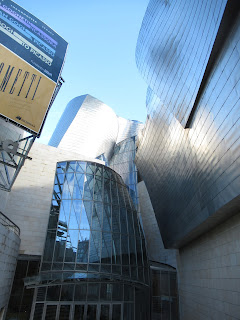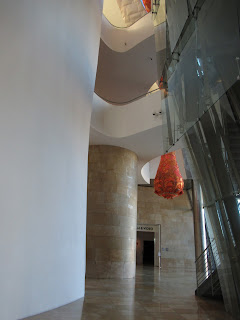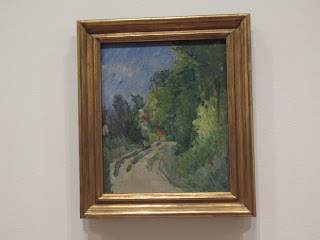We'd come for several days to explore Bilbao - rhymes with cow! - the largest city in northern Spain and also the largest city in the Basque Country or region as a whole. Bilbao was also our base to visit the nearby city of Guernica, the site of a horrific attack by the Germans in the 1930s. I'd read that Bilbao had experienced a transformation like no other Spanish city in recent years due to the construction of a new convention center and the stunning branch of the New York Guggenheim Museum.
In 2010, the city of Bilbao was recognized by Singapore, in collaboration with the Swedish Nobel Academy, for the equivalent of the Nobel Prize for urbanism. In 2013, its mayor received the 2012 World Mayor Prize awarded every two years by the British foundation, The City Mayors Foundation, in recognition of its urban transformation. Then, in 2017, Bilbao was chosen the Best European City 2018 at The Urbanism Awards 2018, awarded by the international organisation The Academy of Urbanism. Pretty heady stuff, don't you agree?!
We had a little bit of time before the Guggenheim Bilbao opened so wandered over to the pretty Dona Casilda Park that was nearby. On the way, we passed the Bilbao Alphabet Museum of all things but we didn't have the time to visit it.
Out back was this sculpture of a man possibly looking over his shoulder, I thought, but didn't know.
Next was this ginormous fabric work of art that wound its way through the atrium and several floors of the museum. It was like a spider or perhaps a centipede and we were seeing its 100 legs all over!
It was notable Serra used iron in his works at the museum as the production and use of iron were first introduced in the Basque country around 600 BC by Celtic or Indo-European peoples from central Europe. The abundance of the mineral in the surrounding mountains gave rise to foundries, the predecessors of modern iron and steel mills.
As discomfiting as part of Serra's work may have been, I really enjoyed the physicality of his work and being able to interact with it rather than simply look at it for a minute or two and then move on to look at something else. Where else in the world could such a huge exhibit be staged?
In 2010, the city of Bilbao was recognized by Singapore, in collaboration with the Swedish Nobel Academy, for the equivalent of the Nobel Prize for urbanism. In 2013, its mayor received the 2012 World Mayor Prize awarded every two years by the British foundation, The City Mayors Foundation, in recognition of its urban transformation. Then, in 2017, Bilbao was chosen the Best European City 2018 at The Urbanism Awards 2018, awarded by the international organisation The Academy of Urbanism. Pretty heady stuff, don't you agree?!
We had a little bit of time before the Guggenheim Bilbao opened so wandered over to the pretty Dona Casilda Park that was nearby. On the way, we passed the Bilbao Alphabet Museum of all things but we didn't have the time to visit it.
The Dona Casilda Park was the largest green space in the city and a beautiful spot to admire more sculptures, walk among the trees and see the pond.
The small monument honored Victims to Terrorism in Bilbao in 2006 by ETA, the Basque separatist group.
If you click on this picture to make it bigger, you'll notice the layer upon layer of individual potted plants!
What a lovely park - it would have been nice to have had both time and decent weather to enjoy Dona Casilda more.
As we walked toward the Guggenheim, located on the riverfront, we were impressed by what we saw of the city's vibrant architecture.
Although Guggenheim Bilbao's collection of modern art was not considered to be superior to other great modern art museums in Europe, it was the building itself, designed by Frank Gehry and opened in 1977, that convinced us to add Bilbao to our Spanish itinerary. Using cutting-edge technologies and unusual materials, he created a piece of sculpture that integrated with the environment and was the perfect stage for some of the best contemporary art. Situated on the banks of the Nervion River, the amazing modern building was covered in plates of titanium which, when the sun shone made it shine.
Guarding the main entrance was the 42-foot tall West Highland Terrier by artist Jeff Koons. Its 60,000 plants and flowers grew through steel mesh and its absolute playfulness reminded us of a carefree childhood. The structure was originally planned to be temporary but Bilbao residents loved it so much, it has now become a permanent fixture in front of the museum.
The first piece to greet us in the atrium was this stunning acrylic flower that just made me smile.
Next was this ginormous fabric work of art that wound its way through the atrium and several floors of the museum. It was like a spider or perhaps a centipede and we were seeing its 100 legs all over!
Except for the floor, there were virtually no straight lines. Sheets of glass made up the staircase and elevator shafts like fish scales overlapping each other. I felt the museum was the art!
Outside on the terrace was a 30-foot tall spider called Maman or Mommy by French-American artist Louise Bourgeois which depicted her mother! The artist indicated the spider "spins a beautiful and delicate web of life ... which is used to entrap her victims." I'm not sure if it made more or less sense to know her mother was a weaver!
Another outdoor piece by Jeff Koons was Tulips, a chrome bouquet of inflatable flowers!
I just loved the colors of the 'centipede.'
An American artist, Jenny Holzer, used nine, vertical LED columns of light in her immensely tall piece called Installation for the Bilbao. I listened twice to the audio guide interpretation but still didn't 'get' it altogether. If I looked carefully, I could see letters changing all the time, but they didn't look like any words in any language I was familiar with.
It had something to do with the medium of language with once forbidden phrases used by a Basque conceptual artist – death, loss and intimacy. A LED column is normally used for ads, not an art installation used to fight against AIDS, according to the audio guide.
The more I saw of the centipede or whatever it was, the more I liked it as there were so many different facets to it and I never knew what to expect and where I might see more of it!
Now, how pretty is this Red Independence
Heart? I bet you would never dream it had been made of plastic cutlery. I had to look really carefully to see the pieces.
I recommend you click on this photo to make it bigger so you can better appreciate Full Steam Ahead. It was made from lots of steam irons, a low pressure hydraulic system, stainless steel , etc!
The art work called Burka was of a man covered by seven layers of fabric which represented the seven layers of fabric worn only by married women in Pakistan, I think. Slowly, it was raised up on a pulley about 30 feet off the ground and then dropped so quickly to the ground it created a huge thud, like what I'd imagine a gun going off to be. That happened time and time again. It represented how women are forcibly hidden by garments, according to the audio guide.
I’m Your Mirror by Joanna Vasconcelos was comprised of 462 small mirrors made to look like an enormous Venetian mask and therefore "hides one’s identity. A mirror reflects its reality but can also distort it." According to the artist, "there is no single identity but many possible ones which change according to the moment. In this work, a mask is a mirror and a mirror is also a mask."
The Matter of Time, a work by Richard Serra, was the artist's "most complete rumination on the physicality of space and the nature of sculpture." The seven sculptures were commissioned in 2005 for the museum's largest permanent gallery. Serra used weathering steel which was highly resistant to atmospheric corrosion and oxidation that rusts over time.
As I walked in and around the relatively simple double helix to the more complex spiral, the works created a dizzying, unforgettable sensation of space in motion. Walking through the works was a real experience - at one point there was such a shift in perspective with a change in the slant of the metal walls, that I almost fell over.
It was notable Serra used iron in his works at the museum as the production and use of iron were first introduced in the Basque country around 600 BC by Celtic or Indo-European peoples from central Europe. The abundance of the mineral in the surrounding mountains gave rise to foundries, the predecessors of modern iron and steel mills.
Despite their enormous size and weight, I was amazed to learn the steel plates weren't anchored to the floor but stood in balance by themselves.
The steel pieces leaned away and to each other and opened and closed at the top. Did it ever feel weird! We were warned not to get too close because rust could come off on our clothes. We were also cautioned to be wary of very small spaces in his art.
The Alberto Giacometti Retrospective of 200 sculptures, paintings and drawings spanned 40 years across all media. He was Swiss but spent most of his life in Paris exploring feelings of isolation even in crowded spaces. These works were from Giacometti's initial Cubist period after moving to Paris when he was inspired by ancient Greek statuary from the Cyclades he’d seen at the Louvre.
The works entitled Women of Venice were done when Giacometti was asked to show his work on behalf of France for the Biennale in Venice in 1956. Giacometti said “I draw better and I write better but sculpture is what I know least and must learn to do better. Every night, I stand before a model and sculpt more or less the way I see it." He stated the sculptures were made with several small modifications so he could keep changing it and improving upon them.
We could see the flashing LED light sculpture on other
floors.
The Thannhauser Legacy marked the first time all the works were not in the Guggenheim in New York. In the galleries we saw works by Cezanne, Van Gogh, Manet, Renoir - a veritable treasure trove of work by some of the world's best artists. The collection included some of Renoir’s early works when his subject matter was darker and his brush strokes were more restrained.
His Woman Dressing or Undressing was quite intriguing as no face was seen and it represented a private moment in her boudoir. Our attention was drawn to her corset because of no face was visible.
Renoir's painting of a woman and her pet parakeet demonstrated this wasn't just any woman in her home. The richness of her dress and her surrealism indicated to people of the period she wasn’t an ordinary housewife but a
courtesan. The dress was the focus of the painting.
We also saw paintings by Rousseau, Picasso, Rothko, Motherwell and Denver’s own Clyfford Still. The geometric art was based on European abstract art of the pre-War period and showed "spiritual, contemplative and symbolic values." I didn't understand that connection at all.
Through the window, I caught a glimpse of Diamond Solitaire Ring made from whiskey glasses with a golden rim representing wealth and luxury as seen from a male perspective! The final shape of the sculpture was the desire for marriage from a female’s perspective, according to the interpretation I listened to.
Surely one of the most imaginative modern art pieces I've ever seen and admired was Marilyn, a pair of high heeled shoes made of stainless steel pots and pans with lids! However do artists conceive of such a work and then get the funding and approval for its installation, I wondered.
Steven told me the most impressive huge sculpture he’d ever seen was the one that wound its way through the museum and evidently into Steven's heart, too. If you'd asked me before we visited the Guggenheim Bilbao, I'd have told you I wasn't much of a fan of conceptual art... If you had to explain something for it to make sense, then I think it missed the point for me. However, I was totally enthralled with so much we saw and did end up enjoying most of the explanations.
We did a lot more that day but I'm saving that for the next post as I'm wiped from traveling all day and this is long enough!
Next post: Bilbao's Begona Cathedral, 350 steps to the old town and more.
Posted on December 17th, 2018, from Amsterdam.















































































What an amazing tour through the Guggenheim Bilbao.. interpretive and interactive art , many larger than life ! And as you know, Ottawa too boasts one of Louise Bourgeois' spiders in front of our national gallery. Loved Marilyn's shoes !! xo
ReplyDeleteLina,
ReplyDeleteI hope to see Bourgeois'spider in front of the National Gallery in Ottawa in July. Perhaps we could see it and the gallery together for a few hours. I need my Canadian fix, after all! XOXO